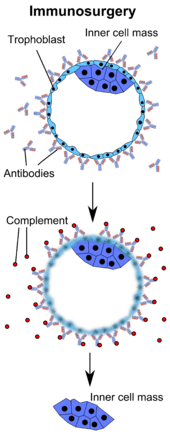Wikiversity Journal of Medicine/Allogeneic component to overcome rejection in interspecific pregnancy
< Wikiversity Journal of Medicine| |
This work is peer reviewed. The peer review statement is located at . A permanent link to the peer-reviewed version is located at . Comments on the peer review statement are located at Talk page |
Mikael Häggström
Sundsvall Regional Hospital, Sweden
ORCID: 0000-0002-2732-7631
Author correspondence by online form
PDF version (checked)
|
Suggested citation format:
First submitted: 26 March 2014 Accepted: 26 March 2014 Last updated: 29 February 2016 Licensing:
|
| |
Media in this article is on display in Wikipedia in the following article: Immunosurgery |
Interspecific pregnancy is a pregnancy involving an embryo or fetus belonging to another species than the carrier. The embryo or fetus is called xenogeneic (the prefix xeno- denotes something from another species), and would be equivalent to a xenograft rather than an allograft, putting a higher demand on gestational immune tolerance in order to avoid an immune reaction toward the fetus. Methods to overcome rejection of the xenogeneic embryo or fetus include the following two:
- Intercurrently inserting an allogeneic (allo- denotes something from the same species) embryo into the uterus in addition to the xenogeneic one. For example, embryos of the species Spanish Ibex are aborted when inserted alone into the womb of a goat, but when introduced together with a goat embryo, they may develop to term.[1]

- Covering the outer layer of a xenogeneic embryo with allogeneic cells. Such envelopment can be created by first isolating the inner cells mass of blastocysts of the species to be reproduced by immunosurgery, wherein the blastocyst is exposed to antibodies toward that species. Because only the outer layer, that is, the trophoblastic cells, are exposed to the antibodies, only these cells will be destroyed by subsequent exposure to complement. The remaining inner cell mass can be injected into a blastocele of the recipient species to acquire its trophoblastic cells.[2] As an example of this method, embryos of Ryuku Mouse (Mus caroli) will survive to term inside the uterus of a house mouse (Mus musculus) only if enveloped in Mus musculus trophoblast cells.[3]
Both of these methods involve a xenogeneic pregnancy in addition to an allogeneic component, that is, either a separate allogeneic embryo or an allogeneic trophoblast. A general hypothesis of overcoming rejection in interspecific pregnancy is that the allogeneic component stimulates gestational immune tolerance, and that this stimulation confers decreased risk of rejection of the xenogeneic embryo or fetus as well. In addition, a directly physical protective effect of an allogeneic trophoblast is also likely. Still, more mechanisms may be involved, and different mechanisms may predominate in different species.
References
- ↑ Fernández-Arias, A.; Alabart, J. L.; Folch, J.; Beckers, J. F. (1999). "Interspecies pregnancy of Spanish ibex (Capra pyrenaica) fetus in domestic goat (Capra hircus) recipients induces abnormally high plasmatic levels of pregnancy-associated glycoprotein". Theriogenology 51 (8): 1419–1430. doi:10.1016/S0093-691X(99)00086-2. PMID 10729070.
- ↑ Zheng, Y.; Jiang, M.; Ouyang, Y.; Sun, Q.; Chen, D. (2005). "Production of mouse by inter-strain inner cell mass replacement". Zygote (Cambridge, England) 13 (1): 73–77. doi:10.1017/S0967199405003035. PMID 15984165.
- ↑ Clark DA, Croy BA, Rossant J, Chaouat G (July 1986). "Immune presensitization and local intrauterine defenses as determinants of success or failure of murine interspecies pregnancies". J. Reprod. Fertil. 77 (2): 633–43. doi:10.1530/jrf.0.0770633. PMID 3488398.